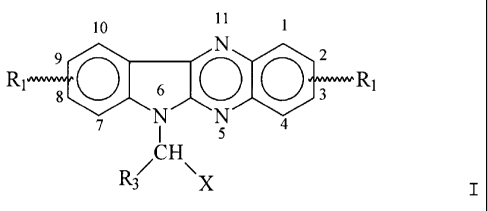Some of the information on this Web page has been provided by external sources. The Government of Canada is not responsible for the accuracy, reliability or currency of the information supplied by external sources. Users wishing to rely upon this information should consult directly with the source of the information. Content provided by external sources is not subject to official languages, privacy and accessibility requirements.
Any discrepancies in the text and image of the Claims and Abstract are due to differing posting times. Text of the Claims and Abstract are posted:
| (12) Patent: | (11) CA 2400236 |
|---|---|
| (54) English Title: | USE OF INDOLOQUINOXALINE DERIVATIVES FOR PREPARING A DRUG FOR THE TREATMENT OF MULTIPLE SCLEROSIS |
| (54) French Title: | DERIVES D'INDOLOQUINOXALINE ENTRANT DANS LA PREPARATION D'UN MEDICAMENT DE TRAITEMENT DE LA SCLEROSE EN PLAQUES |
| Status: | Deemed expired |
| (51) International Patent Classification (IPC): |
|
|---|---|
| (72) Inventors : |
|
| (73) Owners : |
|
| (71) Applicants : |
|
| (74) Agent: | SMART & BIGGAR |
| (74) Associate agent: | |
| (45) Issued: | 2009-09-22 |
| (86) PCT Filing Date: | 2001-02-16 |
| (87) Open to Public Inspection: | 2001-08-23 |
| Examination requested: | 2005-11-25 |
| Availability of licence: | N/A |
| (25) Language of filing: | English |
| Patent Cooperation Treaty (PCT): | Yes |
|---|---|
| (86) PCT Filing Number: | PCT/SE2001/000326 |
| (87) International Publication Number: | WO2001/060371 |
| (85) National Entry: | 2002-08-12 |
| (30) Application Priority Data: | ||||||
|---|---|---|---|---|---|---|
|
Use of a compound of
formula (I) wherein R1 represents hydrogen
or one or several, preferably 1 to 4, similar
or different substituents in the positions 1-4
and/or 7-10, selected from halogen, preferably
Br, lower alkyl/alkoxy group having not more
than 4 carbon atoms, trifluoromethyl group,
trichloromethyl group; and in one of the
positions 7-10 R1 can be a hydroxyl group; X
is a group -(CH2)n-R2, wherein R2 represents
a nitrogen containing basic residue such as
NH2, NHR4 or NR5R6, wherein R4, R5 and R6
independently are lower alkyl or cycloalkyl and n is an integer of from 1 to 4
and R3 represents hydrogen, lower alkyl/cycloalkyl
group having not more than 4 carbon atoms, and the physiologically acceptable
addition products of the compounds with acids and
halogen adducts, preferably adducts with iodine, iodine monochloride or iodine
monobromide, for preparing a drug for treatment
of MS (multiple sclerosis).
L'invention concerne l'utilisation d'un composé de la formule (I) où R1 représente un hydrogène ou au moins un, de préférence 1 à 4, substituants similaires ou différents aux positions 1-4 et/ou 7-10, sélectionnés parmi halogène, de préférence brome, groupe alkyle/alcoxy inférieur ayant maximum 4 atomes de carbone, groupe trifluorométhyle, groupe trichlorométhyle; et, dans une des positions 7-10, peut représenter un groupe hydroxyle; X est un groupe -(CH2)n-R2, où R2 Représente un résidu basique contenant de l'azote tel que NH2, NHR4 ou NR5R6, où R4, R5 et R6 représentent indépendamment alkyle ou cycloalkyle inférieur et n est un nombre entier compris entre 1 et 4 et R3 Représente un hydrogène, un groupe alkyle/cycloalkyle inférieur ayant maximum 4 atomes de carbone, et des produits d'addition physiologiquement compatibles des composés avec des composés d'addition d'acide et d'halogène, de préférence des composés d'addition avec de l'iode, du monochlorure d'iode ou du monobromure d'iode, pour préparer un médicament permettant de traiter la sclérose en plaques.
Note: Claims are shown in the official language in which they were submitted.
Note: Descriptions are shown in the official language in which they were submitted.

For a clearer understanding of the status of the application/patent presented on this page, the site Disclaimer , as well as the definitions for Patent , Administrative Status , Maintenance Fee and Payment History should be consulted.
| Title | Date |
|---|---|
| Forecasted Issue Date | 2009-09-22 |
| (86) PCT Filing Date | 2001-02-16 |
| (87) PCT Publication Date | 2001-08-23 |
| (85) National Entry | 2002-08-12 |
| Examination Requested | 2005-11-25 |
| (45) Issued | 2009-09-22 |
| Deemed Expired | 2011-02-16 |
There is no abandonment history.
| Fee Type | Anniversary Year | Due Date | Amount Paid | Paid Date |
|---|---|---|---|---|
| Application Fee | $300.00 | 2002-08-12 | ||
| Registration of a document - section 124 | $100.00 | 2002-10-29 | ||
| Maintenance Fee - Application - New Act | 2 | 2003-02-17 | $100.00 | 2003-01-23 |
| Maintenance Fee - Application - New Act | 3 | 2004-02-16 | $100.00 | 2004-01-20 |
| Maintenance Fee - Application - New Act | 4 | 2005-02-16 | $100.00 | 2005-01-28 |
| Request for Examination | $800.00 | 2005-11-25 | ||
| Maintenance Fee - Application - New Act | 5 | 2006-02-16 | $200.00 | 2006-01-04 |
| Maintenance Fee - Application - New Act | 6 | 2007-02-16 | $200.00 | 2007-01-26 |
| Maintenance Fee - Application - New Act | 7 | 2008-02-18 | $200.00 | 2008-02-07 |
| Maintenance Fee - Application - New Act | 8 | 2009-02-16 | $200.00 | 2009-02-05 |
| Final Fee | $300.00 | 2009-07-08 |
Note: Records showing the ownership history in alphabetical order.
| Current Owners on Record |
|---|
| LUNDBLAD, LEIF J.I. |
| Past Owners on Record |
|---|
| BERGMAN, JAN |
| MOLLER, LENNART |